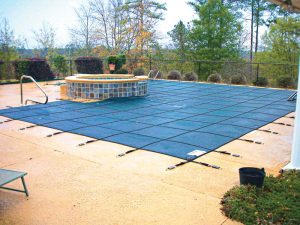By Mark Smith
Covers are an essential part of any customer’s overall pool or spa system. They not only keep debris, dirt, and wildlife out, but can also help keep water in by reducing evaporation. Covers come in a variety of types and styles, from automatic covers which homeowners use year-round for extra safety and security, to manual covers which close the pool in the off-season. Whatever the type of pool or spa cover a client chooses, it turns into a long-term investment.
Pool covers are not necessarily a “fun” part of owning a pool, but they are an important necessity to have and sometimes can be required by homeowners’ associations (HOAs). Given the investment, it is important to talk with homeowners about maintaining their covers and keeping them clean and free from unsafe water accumulation.
In fact, pool cover maintenance should be part of any overall annual service contract providers have with their clients. From opening in the spring, to closing in the fall, and all summer long, ask these questions regarding pool cover maintenance when paying a homeowner a visit.
Is the cover torn or compromised in any way?
Whenever visiting a homeowner’s pool, give the cover a quick visual inspection. Look for rips on seams, frayed edges, or tears anywhere on the cover. Ask the homeowner if any tree limbs or other large debris has hit the cover due to storms or high winds and double check those areas. Then, inspect tie downs or auto cover mechanisms. Upon noticing any issues, check with the cover’s manufacturer for repair kits or consider a cover replacement.
Is the cover clean and clear of debris?

Branches, leaves, and other organic materials can potentially puncture a cover. Periodically, throughout the off season and any time the automatic cover is removed or opened, it should be cleaned of all debris. Use a leaf blower to clear grass, leaves, and other dry and light debris; a skimmer net, a special pool cover “rake,” broom or another long-handled device can help reach and gently remove larger items such as tree branches or mounds of wet leaves. Then, rinse off the cover with a garden hose. If there are stubborn spots of dirt, scrub them with a broom or brush. However, if the cover still is not coming clean, a mild dishwashing liquid can be used. Other harsh cleaning products should never be used as they can be bad for the cover and can also make their way into the pool, creating water quality issues. Once the cover is clean, it is a good idea to give it time to dry before removing and storing it to prevent the build-up of mould or mildew.
The post A must-have pool cover maintenance checklist for service professionals appeared first on Pool & Spa Marketing.







